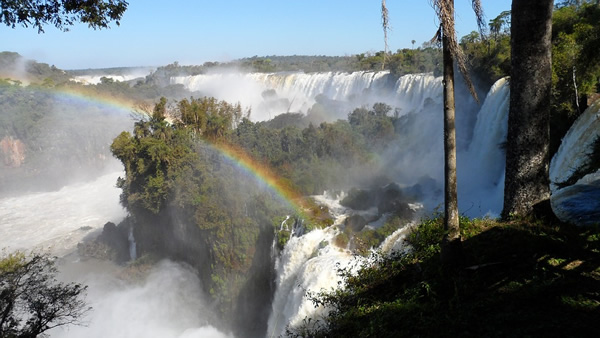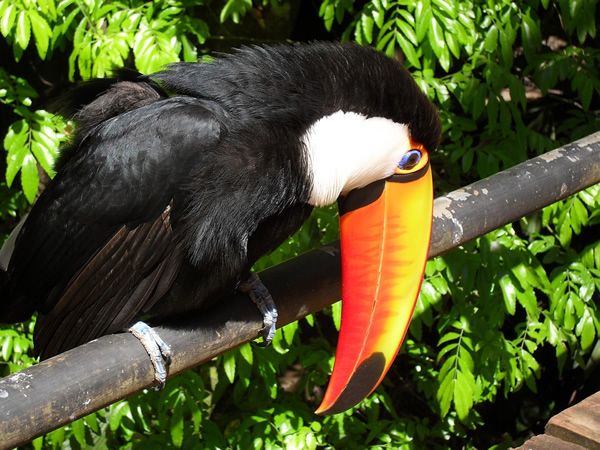Preserving the Flora and Fauna at Iguassu
Conservation at the Border of Argentina, Brazil and Paraguay
By Isabel Eva Bohrer
4/2/2011 resources updated 8/23/2023 by Transitions Abroad

One view of the magical Iguassu Falls.
Waterfalls are roaring all around me. Vapor from the water is constantly rising. A rainbow emerges in between the rays of sun and the water clouds. Surrounded by an emerald-green forest and a clear azure sky, I observe birds swooping down towards the falls. Vencejos, these birds are called. They are unique to the Iguassu Falls.
It‘s impossible to capture in words the sensation one experiences standing on the Devil’s Throat, the most spectacular part of the Iguassu Falls. 150 meters long and 80 meters high, the Devil’s Throat is located on the Argentinean side of the Falls. Here, completely enveloped by the spectacle of the falling water, one experiences a powerful sense of the wonders of nature.
The History of Iguassu
The Iguassu Falls are the main attraction of the Iguassu National Park, situated at the border of Argentina, Brazil and Paraguay. Created in 1934, the Iguassu National Park comprises approximately 67,620 hectars (167,091) acres of land. Its scenic beauty, along with the impressive biodiversity of its subtropical forest, accounts for its declaration as a UNESCO National Heritage site in 1984.
Ever since, the National Park administration has been working hard to conserve the natural beauty along with the countless plant and animal species that inhabit it. With over 1,000,000 visitors coming to the waterfalls each year, such maintainance is certainly no easy job. Especially since it also involves a collaboration between three different countries. But with driving force of human determination, the National Park remains as clean as ever, conserving the wildlife effectively.
More Than Just Waterfalls
The tourists who come to snap their pictures flock to the falls. Significantly fewer of them, however, note that there is much more to Iguassu than the daily boat rides and dinners offered during full moon.
Flora and Fauna
In addition to the waterfalls, the National Park is home to more than 2,000 species of native flora, 450 bird species, 80 mammal species, as well as numerous reptiles, fish, and amphibeans. From luxuriant ferns to colorful toucans to giant climbing plants, the administration seeks to preserve all existing species in the National Park.

A toucan in Iguassu.
Those especially in danger of becoming extinct are protected with special care. Conservation measures are put in place and monitored on a regular basis to preserve, for example, the yaguareté (Panther onca), ocelot (Felis pardalis), the yacutinga (Aburria jacuntinga), macuco (Tinamus solitarius). And these are just several examples of species that are able to survive thanks to the National Park conservation.
In addition to spotting them live in the park, tourists can learn more about these species in the Tourist Center, which has a section dedicated to flora and fauna.
The Guaraní
Conserving Iguassu not only includes wildlife and biodiversity. The National Park is also adamant about preserving the region’s history and culture. Specifically, this includes the Guaraní population.
An ethnic group punished by the European conquerors, the Guaraní have unique customs, which they continue to practice in the region today. To a certain extent, they have had to adapt to the arrival of tourism, offering their crafts for sale in the Iguassu National Park. However, they coexist peacefully with Western traditions, and are able to profit from tourism as they promote themselves as the first inhabitants of the “Tierra Sin Mal,” “the Land without evil.”
To the Guaraní people, the forest is of essential mythological importance as it nurtures life on Earth and moreover, offers a particular cosmogony dependent on the balance between the human species and nature.
Their religion is fundamentally contemplative and based on a unique God, Tupá. The evil spirits, in turn, serve the purpose of castigating those who destroy the forest. In attempting to preserve the natural heritage, the National Park to them is not a threat. On the contrary, it preserves their traditions, and showcases their history. The historical testimonies of Alvar Núñez Cabeza de Vaca and Carlos Bossetti, both of whom reflected extensively on the Guaraní culture, can be read online. Interested tourists can moreover visit the anthropological museum that is also part of the Tourist Center.
The Results Are Not Always Rosy
The effort that has been made to conserve the natural and cultural heritage is tremendous. That is not to say, however, that the results can be seen through rose-colored glasses. Private companies increasingly threaten the area with deforestation. The Argentinean region of Misiones alone, which includes the Iguassu National Park, has lost 40% of its original rainforest.
1999 marked a critical year in the rainforest’s preservation. It was then that Law 3631 was passed, sanctioning Misiones by the “Comprehensive Conservation Area and Green Corridor Sustainable Development.” In basic terms, the law requires that the Green Corridor reserves can only be developed in a way that does not deplete the natural splendor.
The work is on-going. For every visitor, there is a need to preserve the trail that he or she treads. However, it is also tourism that pays the bills to maintain the National Park. On the whole, it has unfortunately proven difficult to accomplish one goal without the other.
Visiting Iguassu
Iguassu can be visited either from the Argentine or Brazilian borders. My recommendation is to visit coming from both countries. Just be aware that some nationalities, including American, require a visa to enter Brazil.
Both towns can be reached by long-distance buses, as well as by plane via the Puerto Iguazú International Airport or Foz do Iguacu International Airport, respectively. There are plenty of accommodations of all kinds — from hostels to high-end chain hotels that can easily be researched online depending upon your preferences.
Last but not least, while it is possible to spend just one day in the park, it is highly recommended to plan at least two if not three days. Given the rich natural and cultural heritage that the park has to offer, you cannot see everything in just a few hours. The first day you will be likely be overwhelmed by the roaring waterfalls; to truly absorb everything, a second or third day will allow you to fully immerse yourself in the wonders.
Isabel Eva Bohrer is the Director and Founder of ROOSTERGNN Global News Network, a non-profit news agency.
|
